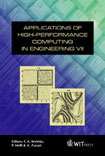Large-scale Parallel Simulation Of Blood Flow Coupled With A Diseased Blood Vessel
Price
Free (open access)
Volume
27
Pages
Published
2002
Size
544 kb
Paper DOI
10.2495/HPC020131
Copyright
WIT Press
Author(s)
Z. Guo, T. Hirayama & T. Matsuzawa
Abstract
Large-scale parallel simulation of blood flow coupled with a diseased blood vessel Z. Guo1, T. Hirayama1 & T. Matsuzawa2 1 Center for Promotion of Computational Science & Engineering, Japan Atomic Energy Research Institute, Japan 2 Center of Information Science, Japan Advanced Institute of Science and Technology, Japan Abstract The objective of the presented study is to develop a LC (Loose Coupling) simulation system implementing two commercial numerical simulation software packages linked by a library called MpCCI (Mesh-based parallel Code Coupling Interface). This library is an essential and a robust tool for carrying out interpolations of the physical variables (values) between different numerical models. We have programmed the MpCCI library into two commercial codes, Mecano and Star-CD, and implemented the developed LC simulation system on a distributed parallel computer by a MPMD (Multi Program Multi Data) parallel programming style. Numerical simulation results of an aneurysm diseased artery acquired by dynamic CSD (Computational Structure Dynamics) coupled transient CFD (Computational Fluid Dynamics) undergoing pulsation blood flow with the LC simulation system is presented which illustrate the mechanical behaviors of the arterial wall. 1 Introduction The coupling simulation is recognized as the most important and effective strategy for studying multidisciplinary phenomena, especially, the so-called FSI (Fluid-Structure Interface) problems in aeronautical engineering, biomechanics, etc. In order to numerically simulate a given FSI problem, the fluid domain is solved by CFD and structure domain by CSD with the interactions between the two domains considered. In the past, various strategies have been proposed and presented to deal with such problems. These methodologies may be grouped into
Keywords




